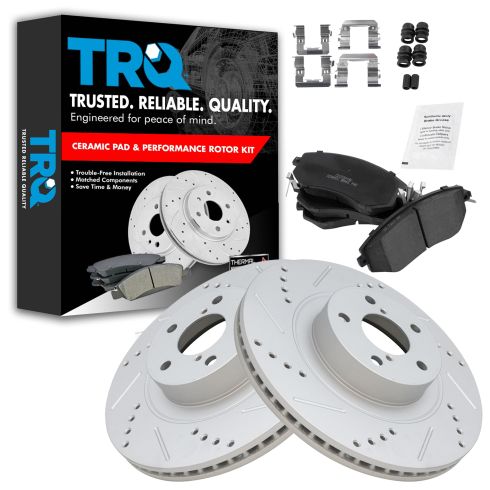1APBS01075-Toyota Subaru Scion Front Ceramic Performance Brake Pad & Rotor Kit TRQ Performance BKA12806

Replaces
2013 Scion FR-S with 11.5 in. (292mm) Diameter Front Rotors Front Ceramic Performance Brake Pad & Rotor Kit TRQ Performance BKA12806

Product Reviews
Loading reviews
5.00/ 5.0
4
4 reviews
rottors
April 5, 2020
i like those rottors and in white color it looks good
June 25, 2022
Great parts
August 24, 2024
Excellent quality and quick delivery.
Quality parts at a good price
September 15, 2024
Wife's car had warped front rotors and would shudder when breaking at any speed over 45mph. This kit fixed everything. Rotors are high quality and the pads seem to be solid. I like that it even had the little rubber bits to replace worn parts on the caliper body. I'll be doing buying the rear brake/rotor kit next.
Customer Q&A
Do you have these in rear ??
September 15, 2021
10
Please provide your 17-digit VIN so we can see if we offer the correct rear brakes for your application.
September 15, 2021
Jessica D
Subaru Crosstrek Front Ceramic Performance Brake Pad & Rotor Kit is out of stock, when will you have it back in stock and the set for the rear brakes? The VIN for my 2016 Subaru Crosstrek is: JF2GPANC9G8275172.
October 3, 2021
10
This front brake kit is listed to fit your vehicle. We expect more to be available around October 8th. This is an estimated date provided by the manufacturer and is subject to chance. The part number for the rear brake kit for your vehicle is. We currently do not carry the cross drilled and slotted rotors for the rear. Part number 1ABFS04309 has regular rear rotors and is listed to fit your vehicle.
October 4, 2021
Andra M
what is the warranty on the
2015 Subaru Forester H4 2.5L Front Ceramic Performance Brake Pad & Rotor Kit TRQ Performance BKA12806 brake pads on rotors?
March 8, 2022
10
This is backed by our limited lifetime warranty. In the event anything should fail due to manufacturing defects during intended use, we will replace the part(s) free of charge. This warranty covers the cost of the part only.
March 8, 2022
Kelly S
Why do the rotors have holes?
July 11, 2022
10
They have holes for venting to prevent overheating of rotors and also extend life of pads.
July 11, 2022
Matthew L
10
Rotors have holes and slots to dissipate heat and remove brake dust accumulation allows Rotors to run cooler and stay cleaner
July 11, 2022
M T
Scion is a registered trademark of Toyota Motor Corporation. 1A Auto is not affiliated with or sponsored by Scion or Toyota Motor Corporation.
See all trademarks.












